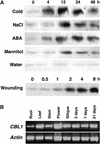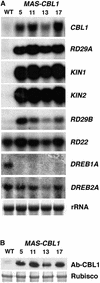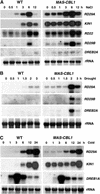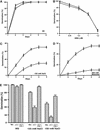CBL1, a calcium sensor that differentially regulates salt, drought, and cold responses in Arabidopsis
- PMID: 12897256
- PMCID: PMC167173
- DOI: 10.1105/tpc.012393
CBL1, a calcium sensor that differentially regulates salt, drought, and cold responses in Arabidopsis
Abstract
Although calcium is a critical component in the signal transduction pathways that lead to stress gene expression in higher plants, little is known about the molecular mechanism underlying calcium function. It is believed that cellular calcium changes are perceived by sensor molecules, including calcium binding proteins. The calcineurin B-like (CBL) protein family represents a unique group of calcium sensors in plants. A member of the family, CBL1, is highly inducible by multiple stress signals, implicating CBL1 in stress response pathways. When the CBL1 protein level was increased in transgenic Arabidopsis plants, it altered the stress response pathways in these plants. Although drought-induced gene expression was enhanced, gene induction by cold was inhibited. In addition, CBL1-overexpressing plants showed enhanced tolerance to salt and drought but reduced tolerance to freezing. By contrast, cbl1 null mutant plants showed enhanced cold induction and reduced drought induction of stress genes. The mutant plants displayed less tolerance to salt and drought but enhanced tolerance to freezing. These studies suggest that CBL1 functions as a positive regulator of salt and drought responses and a negative regulator of cold response in plants.
Figures









Similar articles
-
The calcium sensor CBL1 integrates plant responses to abiotic stresses.Plant J. 2003 Nov;36(4):457-70. doi: 10.1046/j.1365-313x.2003.01892.x. Plant J. 2003. PMID: 14617077
-
Constitutive overexpression of the calcium sensor CBL5 confers osmotic or drought stress tolerance in Arabidopsis.Mol Cells. 2010 Feb 28;29(2):159-65. doi: 10.1007/s10059-010-0025-z. Mol Cells. 2010. PMID: 20077023
-
Comparative proteomic analysis of the Arabidopsis cbl1 mutant in response to salt stress.Proteomics. 2011 Dec;11(24):4712-25. doi: 10.1002/pmic.201100042. Epub 2011 Nov 23. Proteomics. 2011. PMID: 22002954
-
CIPK7 is involved in cold response by interacting with CBL1 in Arabidopsis thaliana.Plant Sci. 2011 Jul;181(1):57-64. doi: 10.1016/j.plantsci.2011.03.011. Epub 2011 Mar 23. Plant Sci. 2011. PMID: 21600398
-
Cell signaling during cold, drought, and salt stress.Plant Cell. 2002;14 Suppl(Suppl):S165-83. doi: 10.1105/tpc.000596. Plant Cell. 2002. PMID: 12045276 Free PMC article. Review. No abstract available.
Cited by
-
Yield and yield components of hybrid corn (Zea mays L.) as affected by mycorrhizal symbiosis and zinc sulfate under drought stress.Physiol Mol Biol Plants. 2010 Dec;16(4):343-51. doi: 10.1007/s12298-010-0035-5. Epub 2010 Dec 7. Physiol Mol Biol Plants. 2010. PMID: 23572984 Free PMC article.
-
Characterization of an 18,166 EST dataset for cassava (Manihot esculenta Crantz) enriched for drought-responsive genes.Plant Cell Rep. 2007 Sep;26(9):1605-18. doi: 10.1007/s00299-007-0378-8. Epub 2007 May 31. Plant Cell Rep. 2007. PMID: 17541599
-
Antisense expression of a gene encoding a calcium-binding protein in transgenic tobacco leads to altered morphology and enhanced chlorophyll.J Biosci. 2007 Mar;32(2):251-60. doi: 10.1007/s12038-007-0025-0. J Biosci. 2007. PMID: 17435317
-
The calcium sensor calcineurin B-like 9 modulates abscisic acid sensitivity and biosynthesis in Arabidopsis.Plant Cell. 2004 Jul;16(7):1912-24. doi: 10.1105/tpc.021311. Epub 2004 Jun 18. Plant Cell. 2004. PMID: 15208400 Free PMC article.
-
Inositol Improves Cold Tolerance Through Inhibiting CBL1 and Increasing Ca2+ Influx in Rapeseed (Brassica napus L.).Front Plant Sci. 2022 Mar 17;13:775692. doi: 10.3389/fpls.2022.775692. eCollection 2022. Front Plant Sci. 2022. PMID: 35371155 Free PMC article.
References
-
- Bray, E.A. (1997). Plant responses to water deficit. Trends Plant Sci. 2, 48–54.
-
- Bush, D.S. (1995). Calcium regulation in plant cells and its role in signaling. Annu. Rev. Plant Physiol. Plant Mol. Biol. 46, 95–122.
-
- Choi, H.I., Hong, J.H., Ha, J.O., Kang, J.Y., and Kim, S.Y. (2000). ABFs, a family of ABA-responsive element binding factors. J. Biol. Chem. 275, 1723–1730. - PubMed
-
- Clough, S.J., and Bent, A.F. (1998). Floral dip: A simplified method for Agrobacterium-mediated transformation of Arabidopsis thaliana. Plant J. 16, 735–743. - PubMed
Publication types
MeSH terms
Substances
LinkOut - more resources
Full Text Sources
Other Literature Sources
Molecular Biology Databases
Miscellaneous

